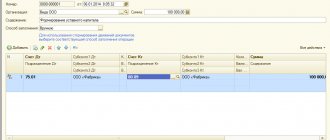Making non-monetary contributions to the authorized capital
According to civil law, the minimum capital of an LLC, and today it is 10,000 rubles, must be contributed by the founders exclusively in money (Clause 2 of Article 66.2 of the Civil Code of the Russian Federation). Anything over this amount, participants have the right to supplement with property: real estate, transport, equipment, office equipment, goods, securities, etc. What property cannot be accepted as a contribution to the authorized capital is regulated by the Charter of the company.
There are also legislative restrictions on the payment of shares in the authorized capital of certain types of property rights, namely:
- the right to perpetual use of lands;
- the right to lease a plot belonging to the forest fund;
- lease right to state and municipal land of a resident of a special economic zone;
- the right to use property transferred to individual entrepreneurs and small and medium-sized businesses.
By contributing their property to the authorized capital, participants transfer the ownership of it to the company. An exception is cases when the act of acceptance for balance contains an indication of the transfer of things for temporary possession and use for a specific period. When the founder leaves the LLC, his property continues to remain in the organization until the date recorded in the act. An existing participant, with the unanimous permission of the general meeting, can withdraw his non-monetary contribution, promptly compensating the company for the costs associated with the acquisition and use of similar property before the end of the established period.
Are such rights an intangible asset?
When determining the methodology for reflecting the fact of receiving a contribution to the authorized capital with lease rights, the main problem is the question of what type of assets the resulting property rights should be classified as. The resulting asset is a property right, an intangible right. In this regard, the first possible answer to the question posed, which logically follows from considering lease rights as an accounting object, is: “intangible assets”.
However, the current PBU 14/2000 “Accounting for Intangible Assets”, approved by Order of the Ministry of Finance of Russia dated October 16, 2000 No. 91n, establishes certain restrictions on the possibility of recognizing an accounting object as an intangible asset.
In accordance with paragraph 3 of PBU 14/2000
Paragraph 4 of PBU 14/2000 establishes that
|
Valuation of property contributions to the authorized capital
All non-monetary contributions both when creating a company and when increasing the authorized capital must be assessed in monetary terms. Until the fall of 2014, for property contributed to pay for a share with a nominal value of no more than 20,000 rubles, the founders themselves could establish the monetary equivalent of the value and record it in the protocol. From September 1, any property contributions are subject to independent assessment. The procedure for valuing property contributed to the authorized capital is regulated by the law on valuation activities (No. 135-FZ of July 29, 1998).
According to 135-FZ, the value of the material contribution included in the authorized capital of the company is determined by independent appraisers based on the market situation. They establish the likely price for which the owner could sell the subject property on the open market as a result of an ordinary sale transaction.
This innovation, according to experts, complicates the process of forming authorized capital for many organizations and makes property contributions unprofitable. In small LLCs, the founders often contribute their shares with items such as office furniture, a laptop or MFP, while each object is subject to assessment, and the burden of paying for the service falls on the owner of the property. The period for compiling an assessment report is on average from 2 days to a week. Most appraisers do not require the presentation of the object itself for examination, but are content with documents and photographs.
What will happen to the organization if it ignores the requirement for an independent assessment? The absence of an appraisal act invalidates transactions involving the contribution of property to the authorized capital, and may also become a basis for invalidating the company’s Charter itself. If the value of a property contribution exceeds the limits under antimonopoly legislation, the FAS obliges not only to evaluate it at the real market price, but also to coordinate such an operation with it before the start of the transaction.
Selection of an independent appraiser
Art. 3 of Law No. 135-FZ, appraisal means professional activity to establish the market, cadastral and other value of objects. The property contributed to the authorized capital of an LLC can be appraised by a specialized company or a private appraiser registered with the relevant self-regulatory organization (SRO). A list of all current SRO appraisers is provided on the Rosreestr website. Before contacting an appraiser, it is recommended to request title documents and a liability insurance agreement.
When it comes to choosing appraisal companies, they often focus on prices. The cost of services varies depending on the region, the reputation of the company, and the type of property: from 1,000 rubles for a laptop to 50,000 or more for securities. The speed of reporting and the willingness to carry out the procedure remotely may be important for owners. The activities of appraisers are not limited geographically, so you can use the services of a company from any region of the Russian Federation.
In Art. 16 Federal Law No. 135 establishes restrictions on the choice of appraisers from the point of view of conflict of interest. A private appraiser or company should not be involved in any way with the customer and his property:
- not be related;
- not to be business partners and not to have an employer-employee relationship;
- not be a creditor or debtor of the client;
- have no rights or property interests in relation to the objects of assessment.
The appraiser is responsible for overestimating the value of the non-monetary contribution transferred by the founder to the LLC. If, within a three-year period from the date of payment/increase in the authorized capital at the expense of the valued property, the participants have subsidiary liability for the obligations of the company, the appraiser is also involved jointly and severally within the limits of the allowed overstatement.
Losses caused by the appraiser are compensated by:
- property of the appraiser-individual;
- funds from the appraisal company;
- compensation under a liability insurance contract within the limits of the insured amount;
- SRO compensation fund up to 5 million rubles per insured event.
Legal regulation of deposits in the management company
The issue is very important and is subject to careful consideration and adjustment. Making a contribution to the fixed capital of an LLC will be accompanied by the re-registration of a large number of documents. You need to remember not only that during the consultation you should have a competent and qualified lawyer next to you, but also that you will have to simultaneously resolve current issues with the organization’s accountants and the tax office.
Legal aspects may concern both consent or denial of the contribution of additional funds to the authorized capital, and decisions regarding the replenishment of the authorized capital from the property of the enterprise itself. People who do not agree with this opinion always have the opportunity to leave the organization by receiving their funds that were previously invested for the purpose of functioning of the organization or enterprise.
All changes in the authorized capital must be legally secured
In case of any changes when increasing the authorized capital and so on, all the nuances must be legally established. Naturally, we can talk about both changing all existing agreements with the founders, and about creating a new sample agreement if we are talking about the entry of a new member into the organization.
The procedure for assessing property contributed to the authorized capital
For a company planning to form/increase its authorized capital through material contributions, the action algorithm is as follows:
- The owners of the property included in the management company select an appraisal company and enter into a simple written agreement with it. The document indicates the object, the method of its evaluation, the full name of the specific appraiser, the SRO in which it is registered and other information in accordance with Art. 10 of Law 135-FZ.
- The customer provides the appraiser with the necessary information, documents, and provides access to the appraisal object.
- The received act on the assessment of the property contribution is approved by the general meeting of LLC participants within 6 months from the date of drawing up the report, as long as it is considered valid. But no later than 4 months from the date of registration of the legal entity. The protocol indicates the object transferred as payment for the management company’s share (name and identifying characteristics), its value in monetary terms, and the decision to establish the value, adopted unanimously. The amount entered in the protocol cannot be higher than the price determined by an independent appraiser.
- The property is transferred to the company according to the transfer and acceptance certificate signed by the participant and the general director of the LLC. The period for contributing shares to the management company when creating a legal entity is determined by the Charter, but according to the law it cannot exceed 4 months.
Procedure for payment of shares in property
The transfer of valuables to the company is carried out in compliance with the rules of Art. Art. 15-16 of Law 14-FZ and Art. Art. 66.2 and the Civil Code of the Russian Federation. The founders draw up a list of property to be contributed in the form of a contribution at the initial stage. When making a decision, participants agree on the value of assets. At general meetings it is determined independently. The exception is the transfer of valuables in an amount exceeding 20 thousand rubles (Clause 2 of Article 15 of Law 14-FZ). In this situation, to confirm the validity of the assessment, a specialist’s opinion is attached to the decision. The calculation is made by an independent expert based on market rates in the region.
Attention! The main documents regarding the value of the property contribution remain the owner’s decision or the minutes of the general meeting. The conclusion of a qualified specialist acts as an annex. The final assessment of the values that are transferred to the authorized capital of the enterprise is approved by the participants. They do this unanimously and in monetary terms (in rubles). The value of the asset is allowed to be set below the figure announced by the expert. The law does not allow only unreasonable overestimation of values. The approach guarantees the fullest possible provision for the interests of creditors.
Lawyers remind that since 2014, the payment terms for shares in capital have changed. Now participants are required to make deposits within 4 months from the date of company registration (clause 1, article 16 of law 14-FZ). During this time, not only acts must be drawn up, but also registration of rights (plots, buildings, transport, securities) must be completed.
Contribution to the authorized capital in goods
The founder contributed goods to the authorized capital. The company is on the general taxation system. What taxes does he need to pay to the budget? The founder has a 100% stake in the management company.
In tax accounting (both under the OSN and under the simplified tax system), when transferring property to the authorized capital, income and expenses do not arise (clause 3 of Article 270, subclause 2 of clause 1 of Article 277 of the Tax Code of the Russian Federation).
For profit tax purposes, the value of the contribution to the authorized capital is recognized as equal to the tax (residual) value of the transferred property.
If the property is transferred by the VAT payer, then he must restore the tax previously accepted for deduction on this property (clause 1, clause 3, article 170 of the Tax Code of the Russian Federation, Letter of the Ministry of Finance dated 08/15/2016 N 03-07-03/47566, dated 09/04. 2015 N 07-01-06/51145, dated 05/14/2015 N 03-03-06/1/27742). Recoverable tax amount:
- if goods are transferred, it is equal to the amount of VAT claimed for deduction on them
The transfer of property to the authorized capital is formalized:
- if a used OS is transferred - by an act of acceptance and transfer of an OS object (for example, according to the OS-1 form). Do not forget to indicate in the act the residual value of the asset according to tax accounting data, its service life and the amount of VAT recovered on it;
- if other property is transferred - by an acceptance certificate (for example, in form M-15), in which the amount of restored VAT must also be indicated.
Accounting (clause 14 of PBU 19/02, Letter of the Ministry of Finance dated 04/28/2016 N 07-01-09/24880).
Acceptance for accounting of the share of property received in payment (in monetary value agreed upon by the company's participants) is reflected in the debit of accounts 08 “Investments in non-current assets”, 10 “Materials”, 41 “Goods”, etc. in correspondence with the credit of account 75 “Settlements with founders", subaccount 75-1 "Calculations for contributions to the authorized (share) capital" (clause 9 of PBU 6/01, clause 8 of PBU 5/01, Instructions for using the Chart of Accounts).
Applications
Related questions:
- Contribution to the authorized capital with property - VAT One of the founders of the company makes a contribution to the authorized capital with property that was brought from abroad. Should this property be taken into account together with customs payments (VAT) or at the contract value? ✒….
- Contribution of the founder to the property of the LLC Our company needs financial support from the founder. Help is needed in selecting the optimal financing mechanism. Consideration is given to gratuitous financial assistance and the founder's contribution to the property. However, in the current version of the Charter this...
- Receipt of fixed assets from the founder Good afternoon! Please tell me how can I take into account and what accounting entries will reflect the receipt of fixed assets from the founder in the organization’s accounting? ✒ In this case, this operation can be carried out….
- Contribution to the authorized capital in foreign currency The LLC decided to increase the authorized capital by 75,000 euros by making an additional contribution by the sole shareholder of the non-resident Company. The Decision to increase the capital capital states that the company’s capital capital increases by 75,000....
Tax subtleties of accounting for property contributions
Income tax
In tax accounting, property received in the form of VUK that meets the criteria of a fixed asset (FA):
- is not recognized as income of the company (subparagraph 3, paragraph 1, article 251, subparagraph 1, paragraph 1, article 277 of the Tax Code of the Russian Federation);
- is accounted for at historical cost (OSC), calculated using the formula:
PSOS = OSPS + DRPS,
Where:
OSPS - residual value of fixed assets according to the tax accounting data of the transferor;
DRPS - additional expenses of the transferring party associated with the transfer of property to the VUK (if these expenses are defined as the VUK - subclause 2, clause 1, article 277 of the Tax Code of the Russian Federation).
If the receiving party does not have documentary evidence of the value of the property VUC in tax accounting, it is recognized as zero (subclause 2, clause 1, article 277 of the Tax Code of the Russian Federation).
Property tax
Property received by the company as a capital asset, accounted for on its balance sheet as a fixed asset, is subject to property tax:
- based on the cadastral value - if the property transferred as a VUK is included in the list of objects for which the tax base is determined as their cadastral value (regardless of the estimated value of the transferred property);
- average annual value according to accounting data - if the property received is not included in the specified list.
Find out about the tax rate for “cadastral” real estate from the article “Step-by-step instructions for calculating property tax from the cadastral value.”
What is needed to make a non-monetary contribution to the authorized capital?
We are going to register an LLC for three people. Now we are thinking about the authorized capital. Couldn't figure out whether the authorized capital of an LLC can be in non-monetary form? For example, if I don’t have free money to invest in a business, can I transfer, for example, a dacha or a car? Will such authorized capital be considered legal? And if it is possible, then who, what body should then evaluate the value of the transferred property? How is this formalized in principle? Where should I go? I heard that sometimes appraisers are brought in. How should the valuation of this property be properly assessed? Should an official or some official person be present when the property is appraised?
06 June 2012, 18:16 Galina, Omsk
Lawyers' answers (2)
City not specified
According to Art. 14 of the Law “On Limited Liability Companies”, the authorized capital of a company is made up of the nominal value of the shares of its participants, the size of the authorized capital of the company must be at least ten thousand rubles, the size of the authorized capital of the company and the nominal value of the shares of the company’s participants are determined in rubles. Thus, the size of the authorized capital of the company must be no less than 10,000 (ten thousand) rubles. At the same time, it must be remembered that at the time of state registration of the company, its authorized capital must be paid by the founders in at least half, and the payment period can be determined by the agreement on the establishment of the company or in the case of the establishment of the company by one person by the decision on the establishment of the company and cannot exceed one year from the date of state registration of the company.
The authorized capital of an LLC can be paid for in money, things, securities, and non-property rights.
The monetary valuation of non-monetary contributions to the authorized capital is approved by a decision of the general meeting, adopted unanimously by all participants of the company (Article 15 of the Law “On LLC”).
Those. the monetary valuation of non-monetary contributions is made and then approved by the participants of the society themselves . however, this is allowed only for deposits worth no more than 20 thousand rubles - if the value of the non-cash deposit is more than 20 thousand rubles. then such contribution must be assessed by an independent appraiser. At the same time, the founders themselves do not have the right to value the property above the price established by independent appraisers. Changes are also made to the documents for registering an LLC. A property valuation act is drawn up (signed by all founders). And we draw up an act of acceptance and transfer of the authorized property for the full balance of the company, necessarily, only after the completion of the state registration of the company (signed by the founder and personally by the general director).
A report on the assessment of non-monetary contributions is an integral element of the package of documents for registration or reorganization of a company. as well as upon purchase. In addition, the assessment of non-monetary contributions is necessary in order to accept them for accounting and tax accounting.
The purpose of assessing a non-monetary contribution is to justify its market value in order to make a decision on the contribution of this non-monetary contribution to the authorized capital. In this case, the market value of the non-monetary contribution to the authorized capital is determined, that is, the price for which it can be sold at the moment.
The importance of correct assessment of a non-cash contribution lies in the fact that the declared value of a non-cash contribution owned by a company will be the basis for calculating property tax and calculating depreciation charges. Thus, the assessment of the non-monetary contribution made to the authorized capital will directly affect the financial performance of the company.
Those. if you decide to make a non-monetary contribution. then I advise that it should not exceed 20 thousand rubles. so that YOU can evaluate the property yourself without involving an appraiser.
You contribute a computer and a printer to the authorized capital. In the decision you will write something like this: Contribute 100% of the share in the authorized capital with property consisting of:
- This computer costs 7,800 rubles.
- This printer costs 2200 rubles.
Total 10,000 rubles.
There is also an accounting aspect when contributing a share of property. If you do not have documents for the acquisition of the contributed property, then for tax accounting purposes (calculation of taxes), its value will be zero. That is, you will not be able to reduce the tax base by income tax or the simplified tax of 15% on the value of such property. If you have such documents, then the value of the property for tax accounting purposes (not to be confused with the valuation of the contribution, which is taken into account only in accounting) will be equal to the value of the property according to the documents, but no more than the value of the valuation (Article 277 of the Tax Code of the Russian Federation).
06 June 2012, 18:27
City not specified
Hello! In practice, there are often situations when the authorized capital of a company is formed partially or entirely from non-monetary contributions. In this case, the assessment of non-monetary contributions in most cases should be carried out by an independent appraiser. When making a non-monetary contribution to the authorized capital of a newly created or reorganized company, the assessment of the non-monetary contribution by an independent appraiser is mandatory.
The purpose of assessing a non-monetary contribution is to justify its market value in order to make a decision on the contribution of this non-monetary contribution to the authorized capital.
In this case, the market value of the non-monetary contribution to the authorized capital is determined, that is, the price for which it can be sold at the moment.
Is it possible to recognize such rights as an intangible asset?
PBU 14/2000, while establishing criteria for classifying an organization's assets as intangible, does not provide a general definition of the concept of intangible assets.
Let's try to understand what intangible assets are as an accounting object.
Intangible assets are non-current non-monetary assets that do not have tangible media, and non-current non-monetary assets, the value (price) of which is many times higher than the value (price) of their tangible media.
This definition includes the following concepts: the term intangible assets itself; fixed assets; non-monetary assets; the value of intangible assets and the value of their tangible media.
Let's look at these concepts in more detail.
The phrase intangible assets means that the balance sheet assets represent some objects, the material embodiment of which is either absent or worth very little. So, for example, a computer program can cost 100,000 rubles, and the disk on which this program is recorded can cost 20 rubles. A secret formula - “know-how”, which defines a new type of product that is destined to conquer the market, can be valued at millions, which is significantly more than the cost of the sheet of paper on which this formula is written. And so on.
In balance sheet theory, non-current assets are expenses that are written off over a period of time t - years, usually more than one year, and/or the least liquid (difficult to sell) property of the enterprise.
In practice, intangible assets are classified as non-current solely due to the requirements of the current accounting legislation PBU 14/00 “Accounting for intangible assets”.
It establishes a list of conditions, the one-time fulfillment of which allows one or another asset to be classified as intangible: (see above). The main one is a period of use exceeding one year. Of course, an enterprise can acquire assets that are essentially intangible and whose service life is less than a year. So, for example, a company can receive a license for a certain type of activity quarterly, purchase a computer program and use it for 10 months, etc.
Non-monetary items of a balance sheet asset that are not related to monetary items are called non-monetary items. Monetary assets are understood as asset items demonstrating the amounts of cash and monetary liabilities. This includes: money, financial investments and accounts receivable.
Our definition of intangible assets, which characterizes them as non-monetary assets, allows us to distinguish this type from the entire group of assets, the value of which significantly exceeds their tangible media.
This is very important, since if, when determining intangible assets, we proceed only from the criterion of a significant superiority of their value over the cost of a tangible medium, then, for example, securities and receivables will also need to be classified as intangible assets. Indeed, when purchasing, say, a share, bond or other security, we naturally pay money not for its form, but for the volume of rights it certifies - intangible property.
Similarly, the fact of the occurrence of receivables from the company’s counterparties is confirmed in documents certifying the execution of the relevant transactions. At the same time, the amount of debts reflected in the assets of the balance sheet significantly exceeds the cost of the forms on which the corresponding primary documents are drawn up.
In both the first and second cases, the enterprise has “incorporeal” (intangible) assets. But due to the adopted accounting methodology, their value is capitalized in the accounts of financial investments and settlements, and not intangible assets.
At the same time, in almost similar situations, we capitalize the amount of the company's expenses as an intangible asset due to only one difference - the characteristics of the corresponding item as non-monetary.
The value of intangible assets and the value of their tangible media are two completely independent quantities. The acquisition of an intangible asset necessarily involves payment of its price or payment of the price of funds ensuring the creation of the intangible asset.
These amounts constitute expenses recorded as intangible assets. The amounts of these expenses represent the value of intangible assets presented in accounting - their accounting estimate. Consequently, the cost of carriers of intangible assets consists of the acquisition prices of the corresponding tangible property - floppy disks, paper and other things. At the same time, the prices of intangible assets and their tangible media should be considered completely separately, since media, as an independent type of property, also have completely independent turnover, that is, they can be produced, bought, sold without being a real carrier of an intangible asset.
From the above it follows that the rental rights received as a contribution to the authorized capital meet all the characteristics of intangible assets that we have identified, however, in accordance with the requirements of PBU 14/2000, they do not apply to them.
What to do? In fact, there is a way out of this situation.
The solution to this problem should be based on the application of paragraph 4 of Article 13 of the Federal Law of November 21, 1996 No. 129-FZ “On Accounting” (hereinafter referred to as the Law “On Accounting”), according to which
| The inclusion of this norm in the Law “On Accounting” meant the introduction into Russian accounting practice of one of the main provisions of International Financial Reporting Standards - the principle of “true and faire” (“true and unbiased representation”), according to which one of the determining factors when choosing a reporting methodology The professional opinion of an accountant should serve in recording the facts of economic life. And if this opinion differs from the requirements of regulatory documents, the accountant can deviate from these requirements by justifying and disclosing his position in the explanations to the organization’s reporting. Consequently, guided by paragraph 4 of Article 13 of the Law “On Accounting”, we have the right to reflect the rental rights received as a contribution to the authorized capital as an intangible asset, disclosing and justifying our position in the explanatory note to the financial statements. In this case, the scheme of entries to reflect the fact of receipt of a contribution to the authorized capital by lease rights will have the following form. The accrual of the shareholder's (participant's) debt on contribution to the authorized capital will be reflected in the entry Debit 75 “Settlements with founders” Credit 80 “Authorized capital” - for the amount of the assessment of the contribution in the constituent agreement. The fact of receipt of a contribution by the rights of ownership and use of property is recorded Debit 04 “Intangible assets” Credit 75 “Settlements with founders” - for the same amount (the amount of the contribution assessment in the constituent agreement). At the same time, an entry in off-balance sheet account 001 “Leased fixed assets” should reflect the fact of receipt of possession of the property in respect of which the rights of ownership and use were obtained. Example 3Organization A receives from organization B a contribution to the authorized capital with the right to own and use production premises for a period of five years. By agreement of the parties, this contribution is estimated at 500,000 rubles. The valuation of the premises itself is 10,000,000 rubles. Let us reflect the facts of accrual of debt B and making a contribution to the authorized capital with rights in the accounting records of A: |







